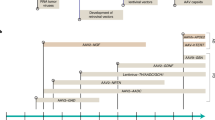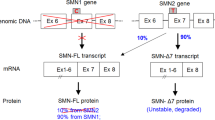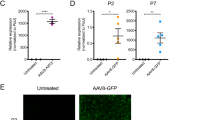Abstract
An experimental approach for gene therapy of spinomuscular atrophy has been reported to prevent development of the neuromuscular features of this lethal and previously untreatable disorder. The approach involves treatment of patients suffering from SMN1-associated infantile form of the disease with a splice-switching antisense oligonucleotide (ASO) that corrects aberrant splicing of the nearly identical SMN2 gene to allow the generation of functional SMN protein, thereby mitigating the development of the disease. This technique represents the first apparently effective therapy for spinal muscular atrophy (SMA) and an important documentation for ASO technology for therapy of neurodegenerative disease. These results with one form of SMA are likely to be relevant for similar applications to other SMA types and are likely to inspire application to a number of other intractable neurodegenerative diseases such as Huntington’s disease, amyotrophic lateral sclerosis and possibly even the extremely common Parkinson’s and Alzheimer’s diseases and others. Nevertheless, the scientific and medical importance of this advance is marred by a pricing policy by the corporate sponsors that may complicate accessibility of the drug for some desperate patients.
This is a preview of subscription content, access via your institution
Access options
Subscribe to this journal
Receive 12 print issues and online access
$259.00 per year
only $21.58 per issue
Buy this article
- Purchase on Springer Link
- Instant access to full article PDF
Prices may be subject to local taxes which are calculated during checkout
Similar content being viewed by others
References
Beltrão-Braga PC, Pignatari GC, Russo FB, Fernandes IR, Muotri AR . In-a-dish: induced pluripotent stem cells as a novel model for human diseases. Cytometry A 2013; 83: 11–17.
Naldini L . Gene therapy returns to centre stage. Nature 2015; 526: 351–360.
Sessa M, Lorioli L, Fumagalli F, Acquati S, Redaelli D, Baldoli C et al. Lentiviral haemopoietic stem-cell gene therapy in early-onset metachromatic leukodystrophy: an ad-hoc analysis of a non-randomised, open-label, phase 1/2 trial. Lancet 2016; 388: 476–487.
Biffi A, Montini E, Lorioli L, Cesani M, Fumagalli F, Plati T et al. Lentiviral hematopoietic stem cell gene therapy benefits metachromatic leukodystrophy. Science 2013; 341: 1233158.
Finkel RS, Chiriboga CA, Vajsar J, Day JW, Montes J, De Vivo DC et al. Treatment of infantile-onset spinal muscular atrophy with nusinersen: a phase 2, open-label, dose-escalation study. Lancet 2016; 388: 3017–3026.
Bishop KM . Progress and promise of antisense oligonucleotide therapeutics for central nervous system diseases. Neuropharmacology 2017; 120: 56–62.
Sridharan K, Gogtay NJ . Therapeutic nucleic acids: current clinical status. Br J Clin Pharmacol. 2016; 82: 659–672.
Lundin KE, Gissberg O, Smith CI . Oligonucleotide therapies: the past and the present. Hum Gene Ther 2015; 26: 475–485.
Arnold WD, Kassar D, Kissel JT . Spinal muscular atrophy: diagnosis and management in a new therapeutic era. Muscle Nerve 2015; 51: 157–167.
Hua Y, Sahashi K, Hung G, Rigo F, Passini MA, Bennett CF et al. Antisense correction of SMN2 splicing in the CNS rescues necrosis in a type III SMA mouse model. Genes Dev 2010; 24: 1634–1644.
Hua Y, Vickers TA, Okunola HL, Bennett CF, Krainer AR . Antisense masking of an hnRNP A1/A2 intronic splicing silencer corrects SMN2 splicing in transgenic mice. Am J Hum Genet 2008; 82: 834–848.
Passini MA, Bu J, Richards AM, Sardi SP, O'Riordan CR, Klinger KW et al. Antisense oligonucleotides delivered to the mouse CNS ameliorate symptoms of severe spinal muscular atrophy. Sci Transl Med 2011; 3: 72ra18.
Singh NK, Singh NN, Androphy EJ, Singh RN . Splicing of a critical exon of human survival motor neuron is regulated by a unique silencer element located in the last intron. Mol Cell Biol 2006; 26: 1333–1346.
Smith RA, Miller TM, Yamanaka K, Monia BP, Condon TP, Hung G et al. Antisense oligonucleotide therapy for neurodegenerative disease. J Clin Invest 2006; 116: 2290–2296.
Hua Y, Sahashi K, Rigo F, Hung G, Horev G, Bennett CF et al. Peripheral SMN restoration is essential for long-term rescue of a severe spinal muscular atrophy mouse model. Nature 2011; 478: 123–126.
Kordasiewicz HB, Stanek LM, Wancewicz EV, Mazur C, McAlonis MM, Pytel KA et al. Sustained therapeutic reversal of Huntington's disease by transient repression of huntingtin synthesis. Neuron 2012; 74: 1031–1044.
Zaghloul E, Gissberg O, Moreno P, Siggens L, Mattias H, Jørgensen A et al. CTG repeat-targeting oligonucleotides for down-regulating Huntingtin expression. Nucleic Acids Res 2017; 45: 5153–5169.
Finkel RS, Chiriboga CA, Vajsar J, Day JW, Montes J, De Vivo DC et al. Treatment of infantile-onset spinal muscular atrophy with nusinersen: a phase 2, open-label, dose escalation study. Lancet 2016; 388: 3017–3026.
Author information
Authors and Affiliations
Corresponding author
Ethics declarations
Competing interests
The author declares no conflict of interest.
Rights and permissions
About this article
Cite this article
Friedmann, T. Gene therapy for spinomuscular atrophy: a biomedical advance, a missed opportunity for more equitable drug pricing. Gene Ther 24, 503–505 (2017). https://doi.org/10.1038/gt.2017.48
Received:
Revised:
Accepted:
Published:
Issue Date:
DOI: https://doi.org/10.1038/gt.2017.48
This article is cited by
-
Advances in therapy for spinal muscular atrophy: promises and challenges
Nature Reviews Neurology (2018)



